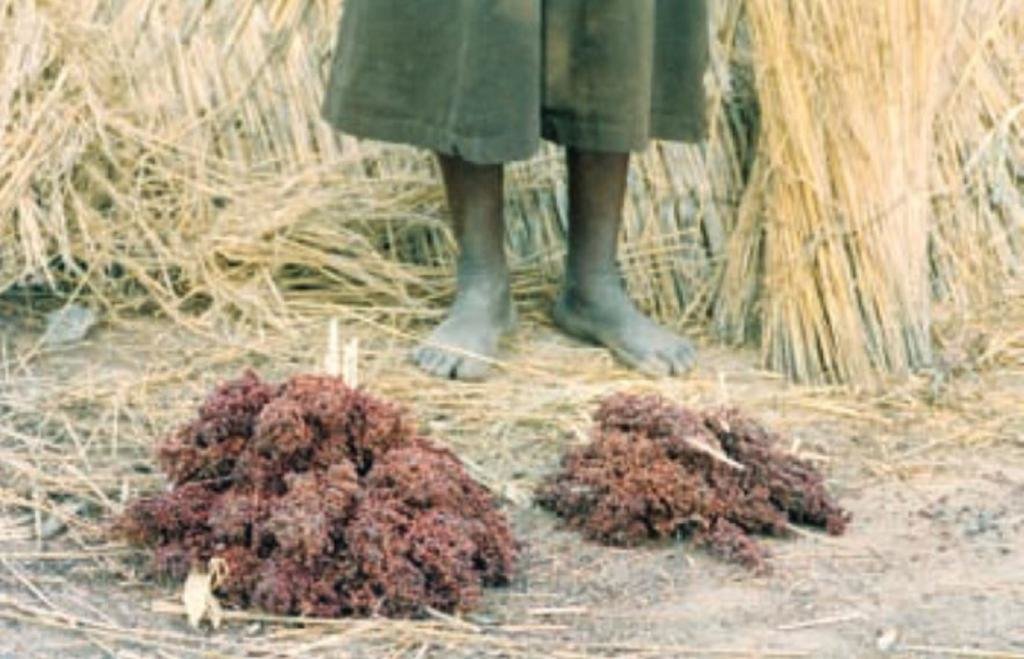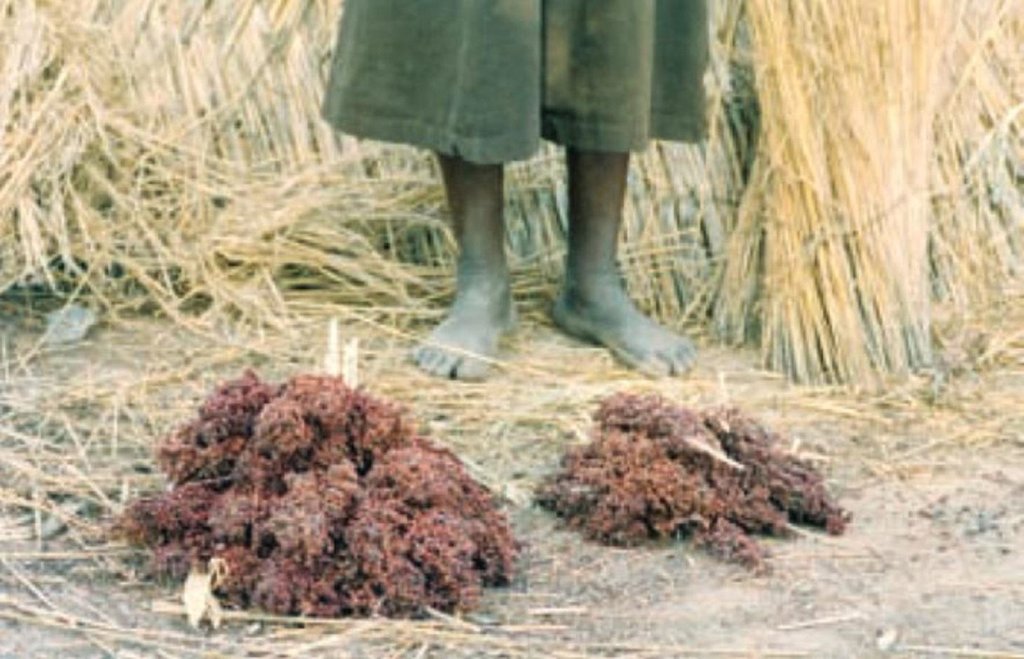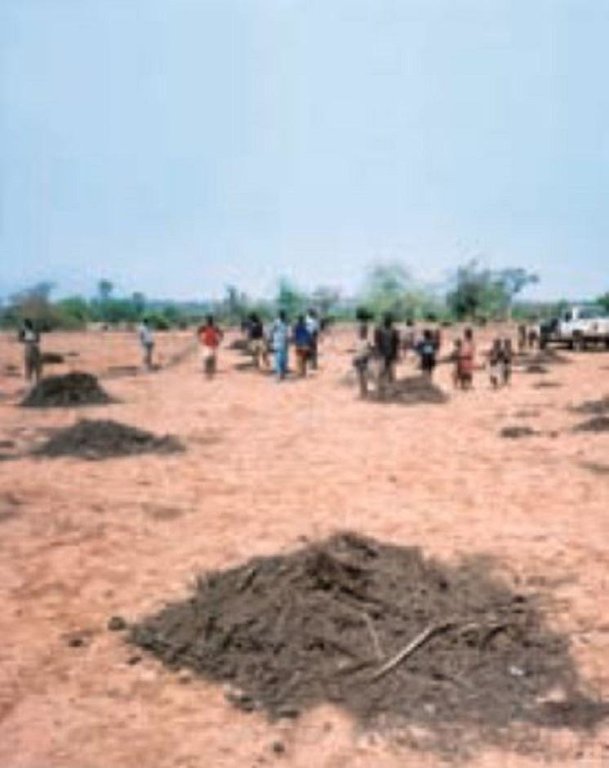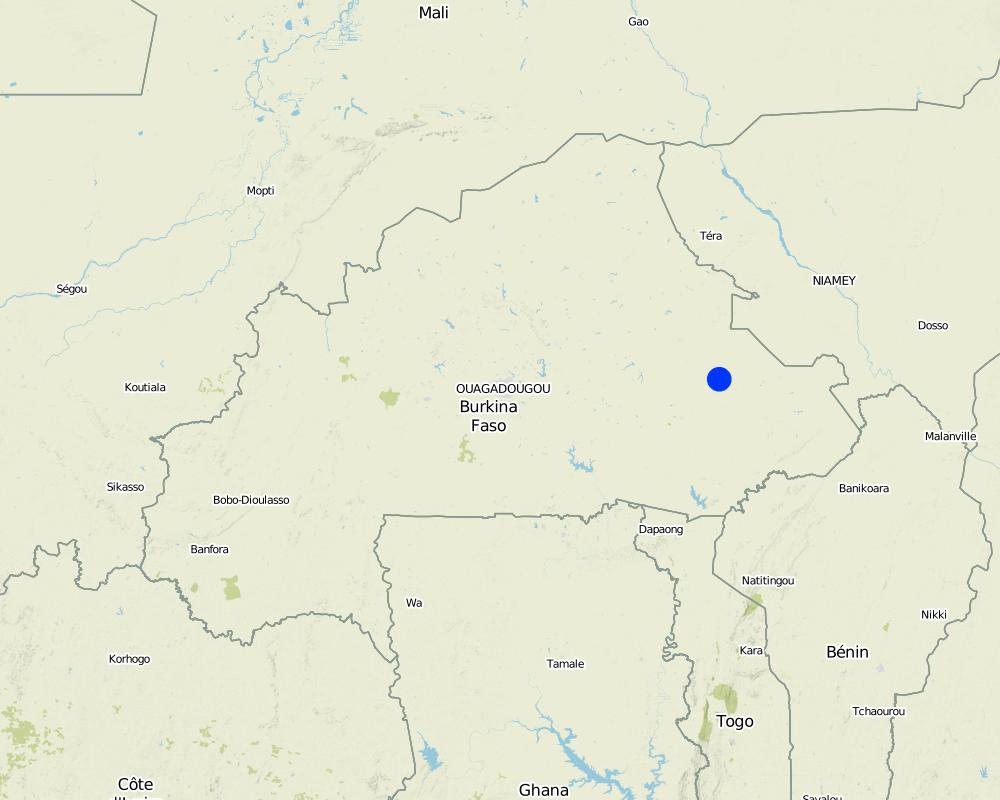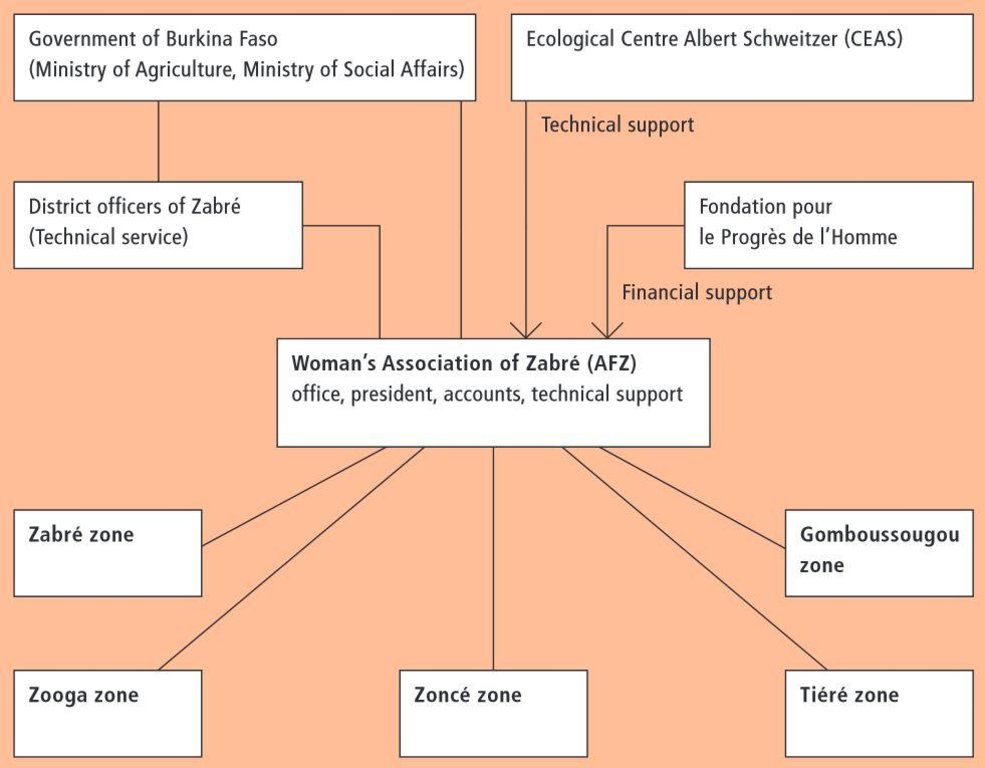Zabré women’s agroecological programme [Буркина Фасо]
- Шинийг нээх:
- Шинэчлэх:
- Эмхэтгэгч: Unknown User
- Хянан тохиолдуулагч: –
- Хянагчид: David Streiff, Deborah Niggli
approaches_2405 - Буркина Фасо
Бүлгүүдийг үзэх
Бүгдийг дэлгэх Бүгдийг хаах1. Ерөнхий мэдээлэл
1.2 Арга барилыг баримтжуулах болон үнэлгээ хийхэд оролцсон хүн эсвэл байгууллагын холбоо барих хаяг
Мэдээлэл өгсөн хүн(с)
ГТМ мэргэжилтэн:
Lougue Maria
Association des femmes Pag-La-Yiri de Zabré (AFZ)
O9 B.P. 335 Ouagadougou 09,
ГТМ мэргэжилтэн:
De Pury Jean Pascal Etienne
ceas.ne@bluewin.ch / ceas-rb@fasonet.bf
ancien directeur du Centre Ecologique Albert Schweitzer
CH-2000 NeuchâFtel, Switzerland, 2 rue de la Côte,
Швейцар
Арга барилыг баримтжуулах/үнэлэх ажилд дэмжлэг үзүүлсэн төслийн нэр (шаардлагатай бол)
Book project: where the land is greener - Case Studies and Analysis of Soil and Water Conservation Initiatives Worldwide (where the land is greener)Арга барилыг баримтжуулах/үнэлэх ажилд дэмжлэг үзүүлсэн байгууллага(ууд)-ын нэр (шаардлагатай бол)
Centre Ecologique Albert Schweitzer (CEAS) - Швейцар1.3 WOCAT-аар баримтжуулсан өгөгдлийг ашиглахтай холбоотой нөхцөл
Эмхэтгэгч болон гол мэдээлэгч хүн(хүмүүс) WOCAT аргачлалаар баримтжуулсан мэдээллийг ашиглахтай холбоотой нөхцлийг хүлээн зөвшөөрсөн:
Тийм
1.4 ГТМ-ийн технологийн асуулгын(д) суурь мэдээлэл(д)

Composting associated with planting pits [Буркина Фасо]
Compost production, and its application in planting pits (zai) by farmers on fields near their homes.
- Эмхэтгэгч: Moussa Bonzi
2. ГТМ Арга барилын тодорхойлолт
2.1 Арга барилын товч тодорхойлолт
A demand-driven initiative, by a women’s association, aimed at the promotion of composting through training and extension, using project staff and local facilitators.
2.2 Арга барилын дэлгэрэнгүй тодорхойлолт
Арга барилын дэлгэрэнгүй тодорхойлолт:
Aims / objectives: Leaders of the women’s association of Zabré (Association des Femme de Zabré, AFZ) initiated a training programme for their members on compost making, and its application in planting pits (zai) after they visited a seminar on the topic in 1987. AFZ actively sought technical and financial help, and found this through the Centre Ecologique Albert Schweitzer (CEAS, based in Switzerland). Support began with the establishment of a first demonstration site where five local facilitators (one from each zone), learned about and developed the technology together over a whole year - comparing the results with sorghum fields without compost. In the following year, those five facilitators each trained 20 women in their zones, using the same training methods as they themselves had experienced. AFZ set up demonstration and training sites in each of the five zones. These demonstration areas were protected by a wire netting fence, contained a well, a cement water tank, and some shade trees for the compost heaps and training sessions. Machines for the wells, hand tools and manure were fully financed, whereas community infrastructure was only partly funded. Each demonstration site had one hectare of cultivated land, with irrigated vegetables in the dry season and sorghum in the rainy season. The facilitators used this land to demonstrate the effect of the compost, and thus to visually convince the trainees. Each of the trainees carried 20 kg of compost home and applied it to their own sorghum fields. During the first 18 months, a CEAS technician visited the zones regularly.
Methods: In the following years, the neighbouring villages each sent groups of 20 women to the established demonstration and training sites, each group for one day a week. They carried out the successive phases of composting in the demonstration plots, while simultaneously implementing the practice at home - where they were supervised by the facilitators as far as possible. In this way, 500 women were trained within one year. Although it took a while, men gradually began to take part and assist their wives when they lost their fear of being ridiculed by others. Many more women then put themselves forward for training. While waiting, they tried to imitate their neighbours, but with mixed results. The support of the CEAS project decreased over the years until 1997, after which it was phased out, being no longer necessary. Training has since continued through the five zonal facilitators and the local agriculture extension service.
2.3 Арга барилын зурагууд
2.5 Арга барил нэвтрүүлсэн улс орон / бүс нутаг / байршил
Улс:
Буркина Фасо
Улс/аймаг/сум:
Boulgou Province
Map
×2.6 Арга барилыг эхлэх, дуусах огноо
Эхлэх жилийг тэмдэглэ:
1987
Хугацаа дуусах жил (Хэрэв арга барил удаанаар ашиглаагүй бол):
1997
2.7 Арга барилын төрөл
- төсөл / хөтөлбөр дээр үндэслэсэн
2.8 Арга барилын үндсэн зорилго, зорилтууд
- train 6,000 women members of AFZ (in 1987) in making compost, and applying it to planting pits (zai) in order to double yields of sorghum or maize - the eventual target is for all farmers of the two departments to make, and apply compost on their fields, - improve the status of women and their livelihoods, - encourage women’s participation in development, - promote training and cooperative action
The SLM Approach addressed the following problems: Since the drought and famine periods of 1970-74 and 1981-84, the main concern of the women in Zabré was how to feed their families. This meant trying to raise crop production again to the pre-1970s average of 800 kg/ha from the level of 400 kg/ha to which it had fallen. The soils were deteriorating because of declining organic matter as increased population led to continuous cultivation without fallow periods. The status of women was low, and they found it hard to generate income through other activities.
2.9 Арга барилын хүрээнд хэрэгжсэн Технологи/Технологиудад дэмжсэн эсвэл саад учруулсан нөхцлүүд
нийгэм / соёл / шашны хэм хэмжээ, үнэт зүйлс
- Хазаарлалт
Men were afraid of being ridiculed in case of failures.
Treatment through the SLM Approach: Contrastingly, women don’t fear being laughed at. The expectation of increasing the yields encourages them to take risks: eventually men also followed for the same reasons.
санхүүгийн нөөц, үйлчилгээний хүртээмж / боломж
- Хазаарлалт
Training of farmers is relatively expensive.
Treatment through the SLM Approach: The donors (Fondation pour le Progrés de l'Homme) and CEAS took care of the approach costs.
Бүтэц зохион байгуулалт
- Хазаарлалт
The existing institution of the women’s association of Zabré (AFZ), which has functioned well for 12 years, needed to adapt to the new agroecological programme promoted by CEAS.
Treatment through the SLM Approach: The management of the AFZ was motivated to adopt and integrate the technology offered by CEAS.
Хууль, эрхзүйн хүрээ (газар эзэмшил, газар, ус ашиглах эрх)
- Идэвхижүүлэх
Even though the land users do not own the land they cultivate (the state officially owns the land, though land use rights are traditional and secure) they receive immediate and full benefits through improved crop yields.
- Хазаарлалт
ГТМ-ийн талаарх мэдлэг, техникийн дэмжлэг авах боломж
- Хазаарлалт
One key question was: how best to teach composting to 6,000 women?
Treatment through the SLM Approach: AFZ already had an extension structure and the five facilitators served as ‘multipliers’
3. Оролцогч талуудын оролцоо ба үүргүүд
3.1 Арга барилд оролцогч талууд болон тэдгээрийн үүргүүд
- Орон нутгийн газар ашиглагч / орон нутгийн иргэд
There were great differences - in the beginning at least - when AFZ merely asked the men to ‘allow’ their wives to learn about composting. After two years, men started to participate in the training and eventually as many of them as women began to make and use compost. Another difference was in discussions, when men tended to dominate.
- ГТМ-ийн мэргэжилтэн/ хөдөө аж ахуйн зөвлөх
- Олон улсын байгууллага
- AFZ
Leaders of the women's association of Zabré
3.2 Арга барилын янз бүрийн үе шатанд орон нутгийн газар ашиглагчид / бүлэглэлүүдийг татан оролцуулах
| Орон нутгийн газар ашиглагч / орон нутгийн иргэдийн оролцоо | Хэн оролцсоныг тодорхойлж, үйл ажиллагааг тайлбарлана уу | |
|---|---|---|
| санаачлага/идэвхжүүлэлт | интерактив | discussion of problems in public meetings |
| Төлөвлөгөө | интерактив | meetings with those in charge of the groups of women farmers |
| Хэрэгжилт | интерактив | in exchange for the training received, some land users volunteered themselves as temporary/part-time facilitators |
| Мониторинг/ үнэлгээ | интерактив | the land users learned to control the quality and the efficiency of their work and voluntarily contributed to monitoring/evaluation - the facilitators were responsible for progress reports |
| Research | идэвхигүй | visit of international researchers to the farms |
3.3 Диаграм (хэрэв боломжтой бол)
Тодорхойлолт:
The agroecological programme of the Zabré Women's Association (AFZ). There are five facilitator’s zones each with:
- 1 president, 1 vice-president
- 1 facilitator
- 1 pharmacy
- 1 cereal bank
- 1 meeting room
- 1 shop
- 1 demonstration/training site
3.4 ГТМ-ийн технологи/технологиуд сонгох шийдвэр
Технологи(д) сонгох шийдвэр гаргасан уу?
- Leaders of the women's association of Zabré (AFZ)
Тайлбар:
in consultation with experts from the Centre Ecologique Albert Schweitzer (CEAS).
Decisions on the method of implementing the SLM Technology were made by Leaders of the women's association of Zabré (AFZ). CEAS, their engineers at Zabré and the facilitators designed the approach, which fitted well into the existing structure of AFZ.
4. Техникийн дэмжлэг, чадавхи бүрдүүлэх, мэдлэгийн менежмент
4.1 Чадавхи бэхжүүлэх/сургалт
Газар эзэмшигчид / бусад оролцогч талуудад сургалт явуулсан уу?
Тийм
Сургалтын хэлбэр:
- фермерээс -фермер
- үзүүлэнгийн талбай
- Олон нийтийн уулзалт
- курс дамжаа
Сургалтын хэлбэр:
- on-farm training
Хамрагдсан сэвдүүд:
Training, as the central focus of the approach, was provided on two levels: project staff trained local facilitators, who then further spread the gained SWC knowledge among the land users. Subjects treated included compost making and application, reforestation, soil protection and anti-erosion measures. station training.
4.2 Зөвлөх үйлчилгээ
Газар ашиглагчдад зөвлөх үйлчилгээ авах боломжтой байдаг уу?
Тийм
Зөвлөх үйлчилгээ үзүүлсэн эсэхийг тогтоо:
- Газар ашиглагчийн талбай дээр
Тодорхойлолт / тайлбар:
Key elements: demonstrations and practical training of of AFZ’s members in the five demonstrationareas in the respective AFZ zones.
4.3 Институцийг бэхжүүлэх (байгууллагын хөгжил)
Арга барилаар дамжуулан институц байгуулагдаж эсвэл бэхжсэн үү?
- Тийм, маш их
Байгууллагууд бэхжиж, үүсэн бий болсон түвшин(үүд)-г тодорхойлно уу:
- Орон нутгийн
Дэмжлэгийн төрлийг ялга:
- Санхүүгийн
- чадавхи бэхжүүлэх / сургалт
- Тоног төхөөрөмж
4.4 Мониторинг ба үнэлгээ
Мониторинг болон үнэлгээ нь арга барилын хэсэг үү?
Тийм
Тайлбар:
bio-physical aspects were regular monitored by 0 through observations; indicators: colour, texture and temperature of compost
technical aspects were regular monitored by 0 through observations; indicators: learning progress and production
socio-cultural aspects were ad hoc monitored by 0 through observations; indicators: effects on input and product prices
economic / production aspects were regular monitored by 0 through measurements; indicators: agricultural output
area treated aspects were regular monitored by 0 through observations; indicators: fields with compost
no. of land users involved aspects were regular monitored by 0 through observations; indicators: trained land users and implementers of technology
management of Approach aspects were regular monitored by 0 through measurements; indicators: CEAS' accounting expertise
There were no changes in the Approach as a result of monitoring and evaluation
4.5 Судалгаа
Судалгаа арга барилын хэсэг нь байсан уу?
Тийм
Дэлгэрэнгүй мэдээллийг өгч, хэн судалгаа явуулсныг бичнэ үү:
Applied research was not part of this approach. However CEAS used previous recommendations from an applied research station in Gorom (Burkina Faso) and thereby adapted the technology to the local situation.
5. Санхүүгийн болон гадаад материаллаг дэмжлэг
5.1 ГТМ-ийн Арга барилын бүрэлдэхүүн хэсгийн жилийн төсөв
Тайлбар (жнь: санхүүжилтийн гол эх үүсвэр / гол хандивлагчид):
Approach costs were met by the following donors: international (CEAS&Fondation pour le progrés del'homme): 80.0%; government (national): 20.0%
5.2 Газар ашиглагчдад санхүүгийн / материаллаг дэмжлэг үзүүлсэн
Технологи / технологийг хэрэгжүүлэхэд газар ашиглагчид санхүүгийн / материаллаг дэмжлэг авсан уу?
Тийм
5.3 Тодорхой зардлыг даахад чиглэсэн дэмжлэгт (хөдөлмөрийн хүчийг оролцуулаад)
- Тоног төхөөрөмж
| Ямар хөрөнгө оруулалт татаасаар олгогдсоныг заана уу | Ямар талбайн хэмжээнд | Тэтгэмж, урамшууллыг тодорхойлно уу |
|---|---|---|
| машин төхөөрөмж | Бүрэн санхүүждэг | machines for the wells on demonstration areas |
| Багажууд | Бүрэн санхүүждэг | |
- Хөдөө аж ахуй
| Ямар хөрөнгө оруулалт татаасаар олгогдсоныг заана уу | Ямар талбайн хэмжээнд | Тэтгэмж, урамшууллыг тодорхойлно уу |
|---|---|---|
| manure | Бүрэн санхүүждэг | |
- Дэд бүтэц
| Ямар хөрөнгө оруулалт татаасаар олгогдсоныг заана уу | Ямар талбайн хэмжээнд | Тэтгэмж, урамшууллыг тодорхойлно уу |
|---|---|---|
| ommunity infrastructure | Бүрэн санхүүждэг | |
Хэрэв газар ашиглагчийн хөдөлмөрийн хүч чухал байсан бол энэ нь аль хэлбэр байсан:
- сайн дурын
Тайлбар:
the hope of increasing yields served as an effective incentive.
5.4 Кредит
Арга барилын хүрээнд ГТМ-ийн үйл ажиллагаанд зориулж зээлд хамрагдсан уу?
Үгүй
6. Нөлөөллийн дүн шинжилгээ ба дүгнэлт
6.1 Арга барилын нөлөөллүүд
Арга барил нь ГТМ-ийн технологийг хэрэгжүүлж, хадгалахад газар ашиглагчдад тусласан уу?
- Үгүй
- Тийм, бага зэрэг
- Тийм, зарим
- Тийм, их
The compost making and its application has helped to improve soil and water management, as the compost returns humus to the soil and increases its water retention capacity and thus improves ground cover.
Did other land users / projects adopt the Approach?
- Үгүй
- Тийм, бага зэрэг
- Тийм, зарим
- Тийм, их
Many women's groups from other regions throughout the country invite delegations from AFZ to teach them compost making. The AFZ delegates are provided with food, accommodation, travel costs and presents in exchange for training. This is much cheaper than the 'official' compost training provided by the Association for Agroecological Technology Development (ADTAE).
6.3 Арга барилын үйл ажиллагааны тогтвортой байдал
Газар ашиглагчид арга барилаар дамжуулан хэрэгжүүлсэн арга хэмжээг тогтвортой хадгалж чадах уу (гадны дэмжлэггүйгээр)?
- Тийм
Хэрэв тийм бол яаж гэдгийг тайлбарлана уу:
The land users are continuing activities and can do so in future, assuming no new problems arise.
6.4 Арга барилын тогтвортой/давуу тал/боломжууд
| Эмхэтгэгч, бусад мэдээлэл өгсөн хүмүүсийн өнцгөөс тодорхойлсон давуу тал/боломжууд |
|---|
| Land users have confidence in their organisation (AFZ) and learn while working in the fields and discussing with the facilitators (How to sustain/ enhance this strength: The facilitators know to nurture this confidence until the land users get profit from the compost (which in turn reinforces that confidence).) |
| AFZ was convinced about the necessity of compost before they knew about CEAS. They searched for a technical collaborator for training and financial support (How to sustain/ enhance this strength: This preliminary motivation is an asset and the technical partner has to fulfil neither less, nor more, than what AFZ expects.) |
| Training of local trainers/facilitators (How to sustain/ enhance this strength: Positive feedback from the farmers will stimulate the facilitators to continue their work.) |
| AFZ represents female land users, it is local and not 'created' by CEAS and is thus an ideal structure (How to sustain/ enhance this strength: CEAS has the knowledge, but AFZ has the power. AFZ needs to learn to use its power to access CEAS' knowledge bank.) |
6.5 Арга барилын дутагдалтай/сул тал/аюул болон тэдгээрийн хэрхэн даван туулах арга замууд
| Эмхэтгэгч, бусад мэдээлэл өгсөн хүмүүсийн өнцгөөс тодорхойлсон сул тал/ дутагдал/ эрсдэл | Тэдгээрийг хэрхэн даван туулах вэ? |
|---|---|
| Internal conflicts within the association may cause problems and there is a danger of CEAS specialists becoming involved in these AFZ rivalries | CEAS should be aware of AFZ power struggles and not get involved. CEAS must stick to its technical role - which is related to knowledge only and not to power. |
7. Суурь мэдээлэл болон холбоосууд
7.1 Мэдээллийн эх үүсвэр/аргууд
- Хээрийн уулзалт, судалгаа
- Газар ашиглагчтай хийсэн ярилцлага
7.2 Холбогдох бүтээлийн ишлэл
Гарчиг, зохиогч, он, ISBN:
UNEP (2002) Enriching soils naturally. In: Success stories in the struggle against desertification pp 5-8
Гарчиг, зохиогч, он, ISBN:
UNEP (2002) Enriching soils naturally. In: Success stories in the struggle against desertification pp 5-8
Холбоос ба модулууд
Бүгдийг дэлгэх Бүгдийг хаахХолбоосууд

Composting associated with planting pits [Буркина Фасо]
Compost production, and its application in planting pits (zai) by farmers on fields near their homes.
- Эмхэтгэгч: Moussa Bonzi
Модулууд
Модуль байхгүй байна



